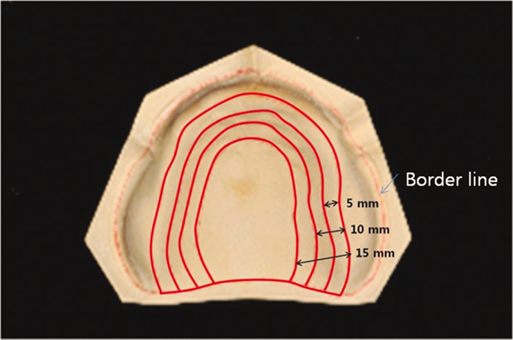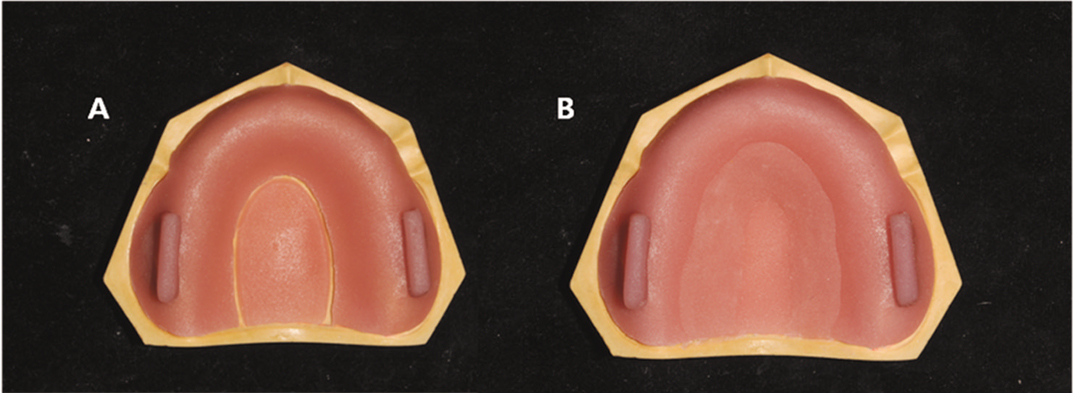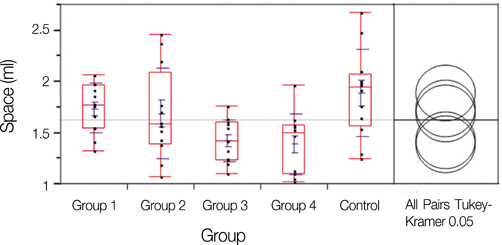J Adv Prosthodont.
2010 Sep;2(3):102-105. 10.4047/jap.2010.2.3.102.
Effect of two-phase fabrication method for the optimum fit of light-polymerized record bases
- Affiliations
-
- 1Advanced Prosthodontics, Graduate School of Clinical Dentistry, Institute for Clinical Dental Research, Korea University, Seoul, Korea.
- 2Esthetic Restorative Dentistry, Graduate School of Clinical Dentistry, Institute for Clinical Dental Research, Korea University, Seoul, Korea. koprosth@unitel.co.kr
- 3Institute for Clinical Dental Research, Korea University, Seoul, Korea.
- KMID: 2118115
- DOI: http://doi.org/10.4047/jap.2010.2.3.102
Abstract
- PURPOSE
The aims of this study were to suggest a method of fabrication of the record base using a light-polymerized resin by applying the two-phase fabrication method for the improvement of the fit of the record base and to compare the degree of fit according to the separation site. MATERIAL AND METHODS: In the edentulous cast of maxilla, four test groups were considered. In the first, second, third, and fourth test groups (n = 12 in each group) the separation was done at 0, 5, 10, and 15 mm, respectively below the alveolar crest along the palatal plane. For the control group, the record base was made without separating the two sections. The light-body silicone material was injected into the fitting surface of the record base. It was then placed onto the cast and finger pressure was applied to stabilize it in a seated position followed by immediate placement onto the universal test device. Finally, the mass of the impression material was measured after it was removed. ANOVA was performed using the SAS program. For the post-hoc test, the Wilcoxon Rank-Sum test and the Tukey-Kramer HSD test were performed (alpha = 0.05).
RESULTS
The control group and Group 3, 4 showed significant differences. The Group 3 and 4 showed significantly smaller inside gaps than the control group which was not made with the two-phase fabrication method.
CONCLUSION
The two-stage polymerized technique can improve the fit of the denture base particularly when the separation was made at 10 to 15 mm from the alveolar crest.
Keyword
MeSH Terms
Figure
Reference
-
1. Nishigawa G, Maruo Y, Okamoto M, Minagi S. Record base for an edentulous maxillary arch with severe undercuts in the labial aspect of the anterior residual ridge. J Prosthet Dent. 2002. 87:99–101.2. Boberick KG, McCool J. Dimensional stability of record bases fabricated from light-polymerized composite using two methods. J Prosthet Dent. 1998. 79:399–403.3. Elahi JM, Abdullah MA. Effect of different polymerization techniques on dimensional stability of record bases. J Prosthet Dent. 1994. 71:150–153.4. Takamata T, Setcos JC. Resin denture bases: review of accuracy and methods of polymerization. Int J Prosthodont. 1989. 2:555–562.5. Sykora O, Sutow EJ. Posterior palatal seal adaptation: influence of processing technique, palate shape and immersion. J Oral Rehabil. 1993. 20:19–31.6. Oh WS, May KB. Two-stage technique for optimum fit and stability of light-polymerized record bases. J Prosthet Dent. 2008. 99:410–411.7. Kim Y, Michalakis KX, Hirayama H. Effect of relining method on dimensional accuracy of posterior palatal seal. An in vitro study. J Prosthodont. 2008. 17:211–218.8. Consani RL, Domitti SS, Rizzatti Barbosa CM, Consani S. Effect of commercial acrylic resins on dimensional accuracy of the maxillary denture base. Braz Dent J. 2002. 13:57–60.9. Takamata T, Setcos JC, Phillips RW, Boone ME. Adaptation of acrylic resin dentures as influenced by the activation mode of polymerization. J Am Dent Assoc. 1989. 119:271–276.
- Full Text Links
- Actions
-
Cited
- CITED
-
- Close
- Share
- Similar articles
-
- A Study on the Accuracy of the record base of the Complete Denture to the Master Cast according to Kinds of Resin and Polymerization Method
- Comparative evaluation of sodium hypochlorite and microwave disinfection on dimensional stability of denture bases
- Comparing accuracy of denture bases fabricated by injection molding, CAD/CAM milling, and rapid prototyping method
- Effect of surface treatment methods on the shear bond strength of auto-polymerized resin to thermoplastic denture base polymer
- Color changes in composites according to various light curing sources




